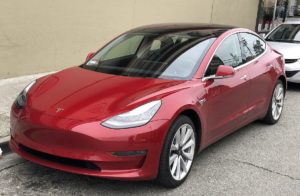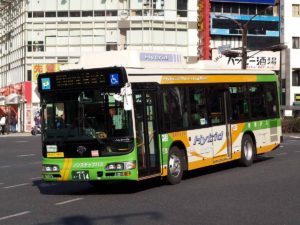Description
Municipalities should plan to transition all of their light- and heavy-duty vehicles to EVs. By doing so, they can model EV adoption for the public. Municipalities also have the benefit of efficiencies from planned multi-year inventory turnover, which allows long-term amortization of purchases balanced against savings from lower fuel and maintenance costs. Moreover, the New York Climate Leadership and Community Protection Act will require that all vehicles in the state, including municipal fleets, be electric by 2050. As a consequence of this policy and manufacturer strategies, by 2035 all new light-duty vehicles sold or leased will be electric.

1
2
Implementation Phases
Transition light vehicles. The municipality should purchase only EVs for light duty vehicles in its fleet to assure that all are EVs by 2030
Transition heavy vehicles. The municipality should develop a phase out plan so that all vehicles will be electric by 2050.
Challenges
Electric power infrastructure must be planned, paid for and installed prior to or concurrent with the purchase and operation of EV fleets. Large-scale “make ready” installations must be coordinated with the local power utility (National Grid in the case of the Capital District), which may have a different timeframe preference than the purchasing jurisdiction.
Heavy duty EVs are developed and introduced to market later than light duty EVs, lagging by several years with increasing lags the heavier the category, resulting in fewer models available and less market knowledge.
Heavy duty vehicles are also more expensive, presenting increased financial risk for early adopters.
Example Municipalities
Several municipalities have already implemented this action…
- New York City intends to have a 100% EV fleet by 2040 in its many aims preparing for a carbon-zero world and sustainable development
- Numerous cities such as Tacoma, Los Angeles, Denver and Boston have already begun to transition their city vehicles to EV’s
Greenhouse Gas (GHG) Reduction
Data
Vehicle fleet in Bethlehem, NY municipal government: 1631 metric tons CO2e per year [Bethlehem 2010 Government GHG Emission, table 3]
GHG emission reduction when switching from gas car to Electric Vehicle: 50% [Electric Vehicles, Emissions and Fuel Economy]
Methodology
We calculated the:
- CO2 emission reduction when government fleet vehicles switch from gas vehicle to electric vehicle.
Results
820 metric tons of CO2e is reduced per year by switching government fleet vehicles from gas to electric.
This results in MODERATE GHG emissions reductions.

Climate Smart Communities (CSC) & Clean Energy Communities (CEC) Link
Transitioning municipal fleets to EVs is well-supported in the CSC and CEC programs, and municipalities are encouraged to follow a specific process to take advantage of available points and competitive funding:
CSC Actions:
- Complete a formal inventory as per CSC’s PE3 Action: Fleet Inventory – 4 points available;
- Develop a formal fleet efficiency policy as per SCS’s PE3 Action: Fleet Efficiency Policy – 2-3 points available;
- Carry out a fleet rightsizing initiative as per CSC’s PE3 Action: Fleet Rightsizing – 1-3 points available; and
- Replace vehicles with advanced vehicles as per CSC’s PE3 Action: Advanced Vehicles – 2-10 points available.
- Municipalities that show GHG reductions in their fleet from a recorded baseline as a result of these CSC actions can earn 15-45 additional points through CSC’s 12-Performance Measure: Reduce GHGs from Government Vehicles.
CEC Actions:
- Municipalities can also earn 300-400 CEC points through CEC’s Clean Fleets high impact action — 300 points for transitioning light/medium duty vehicles to EV, and 400 points for transitioning heavy duty vehicles.

Co-benefits
There are multiple co-benefits to completing this action, including:
- Economic savings over vehicles’ useful life.
- Quieter streets.
- Improves air quality.
- Sets an example for residents and encourages accelerated transition to electric vehicles.
Resources
New York City plans to have a 100% EV fleet by 2040, and police departments worldwide are starting to adopt EVs.,
New York State offers various types of financial support to municipal governments for the purchase of EVs. The Municipal ZEV Rebate program provides rebates to purchase or lease EVs and other zero-emission vehicles for fleet use. The New York State Energy Research and Development Authority (NYSERDA) runs the New York Truck Voucher Incentive Program (NYTVIP), which provides vouchers for the incremental cost of fleet purchases of medium- and heavy-duty EVs. Other EV grants are available through NYSERDA’s Clean Energy Communities Program. NYSERDA also provides point of sale rebates of up to $2,000 for EVs purchases. The State DEC administers the climate smart grant program of the Environmental Protection Fund. Grants are available to localities who want to convert fleets to EVs.
https://www.government-fleet.com/350685/nyc-to-have-100-ev-fleet-by-2040
https://tinyurl.com/y3mwpxwx
https://www.dec.ny.gov/energy/109181.html
https://www.nyserda.ny.gov/All-Programs/Programs/Drive-Clean-Rebate…
https://www.dec.ny.gov/energy/109181.html



